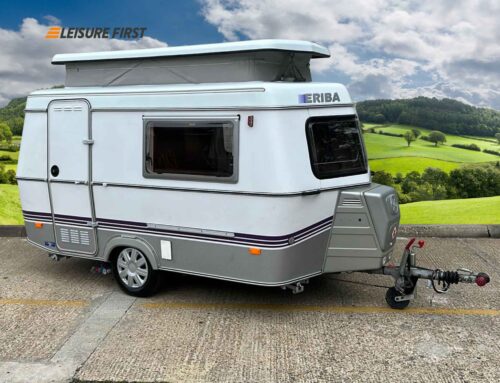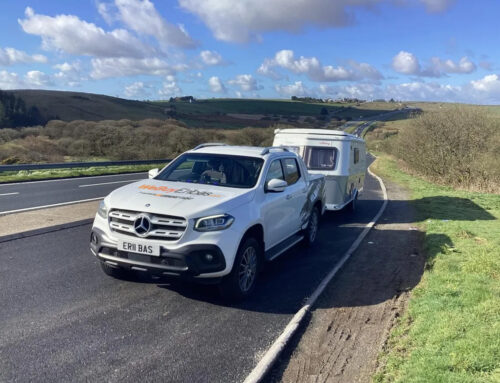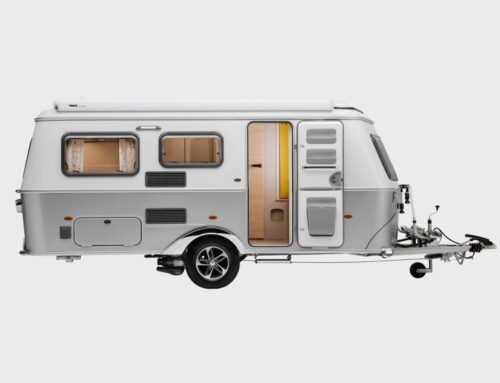Towing an Eriba with a 2023 Hyundai Iconiq 5 Namsan AWD, which has a 77.4 kW hour battery and normally returns 4.2 miles per kW/h in the summer (when most caravan towing is done).
We have an Eriba 530 caravan with a maximum laden weight of 1400 kg.
Towing an Eriba caravan on a 70-mile trip down to Devon from Bournemouth. The weather was sunny and about 24 °C. We used busy ‘A’ roads which frequently had queues of traffic on them a couple of dual carriageways and finally about 5 miles of ‘B’ roads. This journey also included several hilly sections of road either uphill or downhill.
Our stats taken from the car show the journey was 70 miles, we averaged 32 mph, maximum speed 62 mph, and the journey time was 144 minutes. The car logged 2.2 miles/kWh. This worked out to use 47.5% more energy than the same trip would without towing.
(On our reverse journey going home we averaged 2.3 miles/kWh. The roads were less busy but there were several tractors that slowed us up a bit. The journey took 139 minutes).
In the summer months, I would think that working on half the solo range would be a reasonable formula to use. Less in the colder months.
We charge our car mainly at home either with cheap rate Intelligent Octopus Energy at 7.5 pence/kWh or with solar.
The cost of the electricity for the 70 miles was 3.57 pence a mile, charging on the Octopus cheap rate overnight tariff. That is £2.50 total fuel cost for the one-way trip.
We stayed at a Caravan and Motorhome site which allows you to charge overnight plugged into your caravan (not the electricity pillar). This costs £9.00 a night or as explained to us ‘when you generally aren’t using much power’. We charged the first night and the 3rd, our last night. We did not use much power for our 1st night. On the 3rd night, we used more power to make sure our batteries were well-charged for our trip home. On this occasion, we added 110 miles which equates to 33.3 pence/kWh or 70 pence a mile when towing.
Another possibility
We have, over the years, camped off the grid, which has always worked well for us and have installed a larger battery system and a 2kW inverter into our van. This, it turns out has a helpful advantage when charging on caravan sites. We can plug in the car into the caravan to charge at 2 kW (Maximum kW power according to regulations for a granny charger) then if you want to use a kettle, air fryer, etc. plug those into the inverter circuit. They will run off the batteries which will be charged at lower power by the caravan charging system over a longer time. (Subject of course to your inverter, batteries and how the system has been set up).
The Ionic 5 software niggles – ours at least – and maybe other high-tech EVs
Our Iconiq 5 recognises when a trailer has been attached and will automatically, or manually if you prefer, change the cluster to show the caravan is plugged in and driving range whilst towing.
The rear sensors/camera system will recognise the caravan and apply the brakes making it impossible to back the van into an allocated pitch. These sensors can be turned off in the software setting (although our car had this switched off on the dash cluster the car still would not reverse). This system needs to be reactivated when not reversing or towing as it does not automatically return to the default ‘on’ position.
On the same theme, one of the very few negative points about the Ioniq 5 is the very poor turning circle that it has. If the rear sensors have not been disabled, this can make it difficult to get out of tight parking spaces as the car sees the caravan as an obstacle and auto brakes to a stop meaning you won’t be able to reverse back to take another line. A motor mover may be a way of mitigating this issue but adds extra work to resolve an issue that could have been designed from day one.
The removable tow bar is supplied and fitted by Hyundai – as the car is quite low riding the tow bar is also lower than usual. This results in difficulty in connecting the electrics of the caravan to the car as not only do you need to be at ground level to make the connection but you have to try and hold the spring cover open in a space where it won’t easily open wide enough to accommodate the plug.
Probably the easiest way to overcome the above issue is to connect the car to the caravan with the back wheels on a pair of levelling ramps (as I do to clip the tow bar in place).
Conclusion
So when it comes to towing an Eriba the Ioniq 5 is a great all-rounder, powerful, spacious, comfortable, intuitive tech and very well suited for towing. The car performs very well towing even in Eco mode. It feels more than capable of towing an Eriba and it is easy to forget that there is a caravan on the back.
Interestingly while in Eco mode the car normally only uses RWD, but whilst towing our caravan it engaged AWD, selecting it on inclines and reclaiming regen energy through both axials if required.
Even with a caravan on the back, it could outperform many cars which did not have a caravan on the back.
![Towing an Eriba with 2023 Hyundai Iconiq 5 Namsan [1]](https://www.leisurefirst.com/wp-content/uploads/2023/07/towing-an-eriba-002-scaled.jpg)
![Towing an Eriba with 2023 Hyundai Iconiq 5 Namsan [2]](https://www.leisurefirst.com/wp-content/uploads/2023/07/towing-an-eriba-003-scaled.jpg)
![Towing an Eriba with 2023 Hyundai Iconiq 5 Namsan [3]](https://www.leisurefirst.com/wp-content/uploads/2023/07/towing-an-eriba-004-scaled.jpg)
![Towing An Eriba from Bournemouth to Devon [1/4]](https://www.leisurefirst.com/wp-content/uploads/2023/07/towing-an-eriba-001-scaled.jpg)




